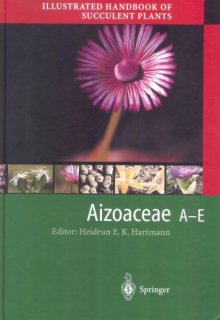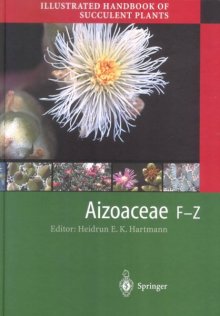![]()
AIZOACEAE A-E has 54 figures and 384 colour photos, printed in 48 colour plates Prices and availability
AIZOACEAE F-Z has 85 figures and 384 colour photos, printed in 48 colour plates Prices and availability
Price: £83.50 per volume, postage may be extra.
 Contributions by: C. Bruckmann, P. Chesselet, Prof D.T. & N.A. Cole, Dr. M. Gerbaulet, S.A. Hammer, B. Hansen, PD Dr. H.E.K. Hartmann, Prof. Dr. H.-D. Ihlenfeldt, C. Klak, I. Niesler, Dr. S.M. Pierce, Dr. M. Struck-Gerbaulet & Dr. N. Zimmermann plus contributors of photographs and artwork.
Contributions by: C. Bruckmann, P. Chesselet, Prof D.T. & N.A. Cole, Dr. M. Gerbaulet, S.A. Hammer, B. Hansen, PD Dr. H.E.K. Hartmann, Prof. Dr. H.-D. Ihlenfeldt, C. Klak, I. Niesler, Dr. S.M. Pierce, Dr. M. Struck-Gerbaulet & Dr. N. Zimmermann plus contributors of photographs and artwork.
With Jacobsen's succulent lexicon of the 1950s impressed firmly on my mind I was expecting a state of the art, full colour, fully updated, expanded and rewritten reference work to replace the third volume of his opus.
Jacobsen's third volume covered the Mesembryanthemaceae, but these two volumes embrace the wider subject, Aizoaceae and include plants which the majority of us would not wish to grow, neither would the plants be suitable for the majority of our conditions.
My first disappointment was that the volumes were not in slip cases; given that they are reference works, it would have added to their longevity and at £83.50 they should have been.
It has obviously been assumed by the publishers that there would be some purshasers of one volume who would not want the other, for the Introduction is repeated in the second volume which is rather a waste; in fact the first 22 pages of text are common to both volumes.
From page 23 on in each volume the individual genera are examined with the authors name given for each genus. All genera are given, including those which have been subsumed, tranferred and in any other way disposed of. Unlike Jacobsen's trilogy full bibliographic references are quoted, an invaluable inclusion for all students and something which makes them a 'must have' for anyone undertaking serious botanical work on the family.
For each species which is extant a full description of the type is given, a distribution map, a key to the species and description of the species. The descriptions are much better than those in Jacobsen which are often extremely brief. Species which have been reclassified are given with their new classification. There are no cultivation notes, this is not the object of these works, plenty has been written recently to satisfy that need.
 After all the genera entries, there are 17 pages of references, again, but more understandably, these are common to both volumes.
After all the genera entries, there are 17 pages of references, again, but more understandably, these are common to both volumes.
Following at the end of each volume are the colour plates. These have been so obviously tacked-on in order that the title of the volumes might be more appealing, to validate the "Illustrated" of the title. How much more effective it would have been to have had the illustrations within the text; it would unfortunately have increased the costs and possibly lengthened further the production time.
With each page measuring 7.5" x 10.5" approximately, and with eight photographs on each plate I leave it to you to work out the size of each photo. Those who donated their excellent slides to this project must be bitterly disappointed at their reproduction, both in size and hue. A good example to turn to is the plates of Conophytums; we have just received Steven Hammer's "Dumpling and his Wife" and comparing the photos, which are the same slides in many cases, the richness of colours is entirely missing. Even the Lithops photos taken by Desmond Cole seem dark and a world away from those in his Lithops book. In many cases the plates are useless as an identification aid, particularly those of the less compact plants, it could be anything we are looking at. In the world of the Aizoaceae colour is everything. Jacobsen's mesemb volume has been criticised for the poor black and white photos but that was many years ago.
It has taken a lot of hard work on the part of Heidi Hartmann to bring these volumes to print. I am sure that there were times when she thought that they never would be published. She has battled with first one publisher and then another as the first was taken over; I know that this is an over simplification and that I cannot possibly understand the full extent of the energy, the single mindedness and belief in this project which was required of her. The importance of this work cannot be over-emphasized and it will remain as a major milestone in the literature of the family for years to come. It is just a pity that its cost will put it out of the range of many amateur growers.
![]()

